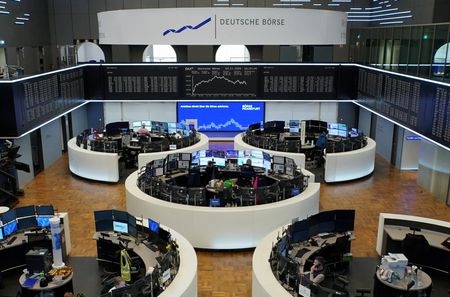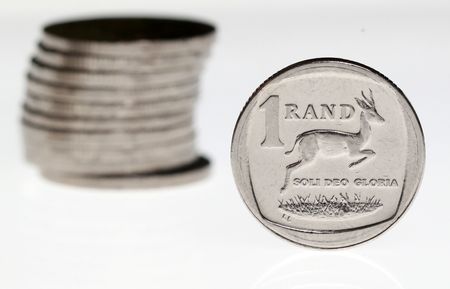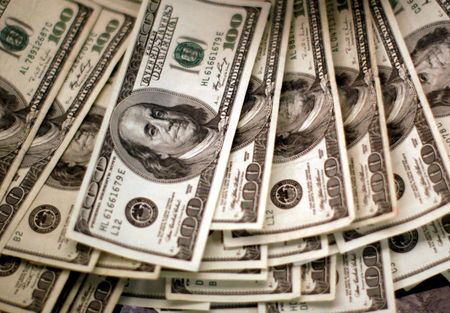By Lucy Raitano and Kevin Buckland
LONDON/TOKYO (Reuters) -European stock markets slipped on Tuesday as a recent tech-fuelled rally faded and top Wall Street banks warned of a stock market selloff, while the dollar rose to a three-month high.
The pan-European STOXX 600 was last down 0.9%, having earlier slipped as much as 1.6%. Earlier, Asian shares tumbled from all-time highs as investors booked profits following strong tech-led gains over recent weeks.
U.S. futures last pointed sharply lower on Tuesday, with S&P futures down 1% and Nasdaq futures off 1.3% .
The chief executives of Goldman Sachs and Morgan Stanley warned at an investment summit in Hong Kong of the prospect of a stock market correction of more than 10% over the next two years.
SIGNS OF AI CAUTION
Michael Brown, senior research strategist at Pepperstone, said some market participants regarded a slide in Palantir shares post-earnings as indicative of a greater degree of scepticism about the AI theme.
“I’m not entirely sure I buy into that, but that’s the story that’s going around,” said Brown.
He also pointed to technical factors on the S&P 500 that could have exacerbated selling pressures.
“Ultimately I think this is a pause in the broader rally, rather than the tide sort of definitively turning against the bulls,” he said.
Palantir Technologies fell almost 6% in early Frankfurt trading on Tuesday after earnings released on Monday.
Palantir stock trades at an eye-watering 12-month-forward price-to-earnings ratio of 246.2, compared with Wall Street darling Nvidia’s <NVDA.O> 33.3, according to LSEG data.
The catalyst for the latest leg up in stocks was Amazon’s $38 billion cloud services deal with ChatGPT creator OpenAI.
“People are turning cautious about these circular transactions around AI, with Nvidia at the centre of everything,” said Tony Sycamore, an analyst at IG.
“It’s concern about all the capex that’s been spent, without knowing where the revenue is going to come from.”
On a tech earnings discussion and Q&A call on Tuesday, Kristofer Barrett, fund manager and head of global equities at Carmignac, said he remained confident on AI, flagging increasing big tech capex guidance.
But he also flagged “excess hyping” of recent deals as a worry.
“..From a market perspective it’s pretty bad, because we’re basically pulling forward newsflow, we’re talking about things we’re going to do three years from now, if we’re already discounting that… that obviously takes away potential from future returns,” he said
“It also starts discussion around, ‘Is this a bubble?'”
Barrett highlighted a recent run higher of unprofitable tech stocks, noting that some parts of the market – not necessarily AI-related but in other tech sectors like space and quantum – are reaching high market caps despite not being profitable and in some cases not even having products out.
UK, U.S. ECONOMIES IN FOCUS
Britain was in focus after a speech on Tuesday by its finance minister Rachel Reeves that appeared to pave the way for broad tax rises, weighing on UK gilts.
Broader sentiment was also dampened by weakness in U.S. economic data, while a divergence in views among Federal Reserve officials clouded the outlook for a December interest rate cut.
The U.S. dollar rose to a nearly nine-month peak versus the yen, as well as a three-month high against the euro.
The U.S. dollar was supported by reduced bets for near-term Fed easing, edging up to 154.8 yen for the first time since February 13, and to $1.149 per euro for the first time since August 1.
However, those advances evaporated as traders bought the yen and euro for their haven appeal as stock markets slid.
The polarised views on policy among Fed officials have also become a source of worry for the market, particularly with official economic data still suspended due to the federal government shutdown, leaving investors groping in the dark for clues on U.S. economic health.
Accounts from manufacturers in the private Institute for Supply Management survey on Monday painted a dire picture of the factory sector, showing U.S. manufacturing contracted for an eighth straight month in October as new orders remained subdued.
Fed Governor Stephen Miran on Monday restated the case for deep rate cuts, while Chicago Fed President Austan Goolsbee said he was leery of further reductions while inflation remained significantly above the central bank’s 2% target.
The Fed lowered rates last week but Chair Jerome Powell suggested that might have been the last cut of the year.
Traders are now pricing in a 67.3% chance of a rate cut in December, compared with 90.5% a week earlier, CME FedWatch showed.
Gold failed to benefit from haven flows, as it continued to find its footing following a sharp retreat from a record high in mid-September. Bullion was last down 0.4% at around $3,987 per ounce.
Crude oil prices slipped as markets read OPEC+’s decision to pause output hikes in the first quarter as a signal of oversupply in the market.
Brent crude futures edged down 1.3% to $64.08 a barrel.
(Reporting by Kevin Buckland. Editing by Sam Holmes and Mark Potter)












